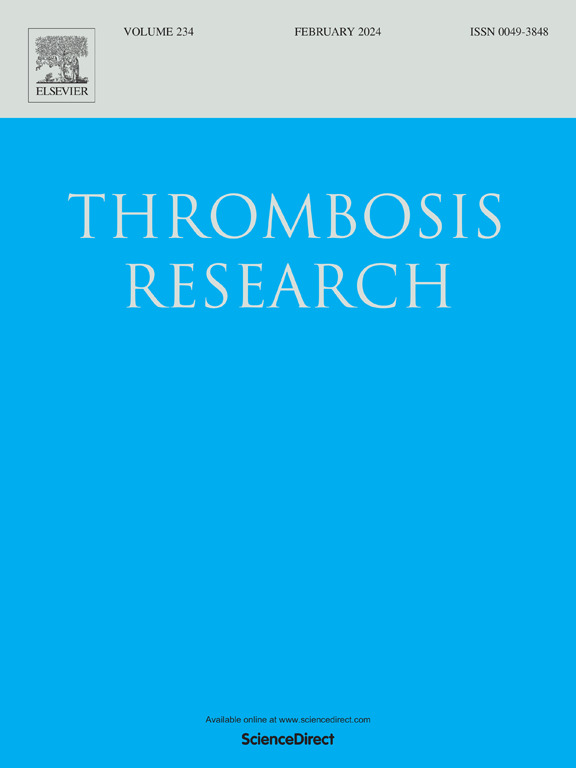jak2v617f阳性细胞外基因组物质驱动骨髓增殖性肿瘤的内皮炎症和血栓形成
IF 3.4
3区 医学
Q1 HEMATOLOGY
引用次数: 0
摘要
内皮细胞(ECs)在血管炎症和血栓形成、骨髓增生性肿瘤(mpn)的中枢过程中起着关键作用。血管并发症,特别是血栓形成,是MPN发病率和死亡率的重要因素;然而,内皮功能障碍的分子机制仍然不完全清楚。在这项研究中,我们研究了jak2v617f阳性的细胞外基因组物质(EGMs)——包括来自HEL细胞的游离DNA (cfDNA)和外泌体——对内皮炎症、凝血和核酸感应途径的影响,以阐明它们在mpn相关血管病理中的作用。用jak2v617f阳性EGMs和培养上清液(CS)处理人脐静脉内皮细胞(HUVECs)。我们通过RT-PCR、ELISA和流式细胞术评估了细胞增殖、细胞凋亡、HMGB1表达和释放、细胞因子分泌、核酸敏感途径激活和凝固相关基因表达。我们已经证明,外泌体对内皮活化、强劲的HMGB1分泌和细胞因子释放(包括IL-1β、IL-6和MCP-1)的影响最为显著,这表明cfDNA激活了早期炎症,而cfDNA诱导了细胞内HMGB1积累,细胞外释放有限。我们进一步证明,jak2v617f阳性EGMs激活核酸传感通路(cGAS-STING和TLR9),导致促炎介质如NF-κB、IRF3和IRF7的表达增加。凝血相关基因(F10, F3, F2RL1)和粘附分子(ICAM-1, TF)的上调证实,EGM暴露促进了ECs中的促血栓表型,反映了MPN患者的高凝状态。由于我们的体外系统缺乏血液流动动力学和免疫细胞相互作用等生理条件,因此需要在具有不同JAK2V617F等位基因负荷的患者来源样本和体内模型中进一步验证。尽管如此,这些发现建立了致癌egm与mpn血管并发症之间的机制联系,强调了它们在慢性炎症和血栓形成中的作用。靶向egm介导的内皮功能障碍可能提供一种新的治疗方法来减轻MPN患者的血管并发症。本文章由计算机程序翻译,如有差异,请以英文原文为准。

JAK2V617F-positive extracellular genomic materials drive endothelial inflammation and thrombosis in myeloproliferative neoplasms
Endothelial cells (ECs) play a pivotal role in vascular inflammation and thrombosis, central processes in myeloproliferative neoplasms (MPNs). Vascular complications, particularly thrombosis, contribute significantly to MPN morbidity and mortality; however, the molecular mechanisms underlying endothelial dysfunction remain incompletely understood.
In this study, we investigated the effects of JAK2V617F-positive extracellular genomic materials (EGMs)—including cell-free DNA (cfDNA), and exosomes, derived from HEL cells—on endothelial inflammation, coagulation, and nucleic acid-sensing pathways to elucidate their contribution to MPN-associated vascular pathology. Human umbilical vein endothelial cells (HUVECs) were treated with JAK2V617F-positive EGMs and culture supernatant (CS). We assessed proliferation, apoptosis, HMGB1 expression and release, cytokine secretion, nucleic acid-sensing pathway activation, and coagulation-related gene expression via RT-PCR, ELISA, and flow cytometry.
We have demonstrated that exosomes exhibited the most potent effects on endothelial activation, robust HMGB1 secretion and cytokine release, including IL-1β, IL-6, and MCP-1, indicating activation of early inflammation while cfDNA induced intracellular HMGB1 accumulation with limited extracellular release. We further demonstrate that JAK2V617F-positive EGMs activate nucleic acid sensing pathways (cGAS-STING and TLR9), leading to increased expression of proinflammatory mediators such as NF-κB, IRF3, and IRF7. The upregulation of coagulation-related genes (F10, F3, F2RL1) and adhesion molecules (ICAM-1, TF) confirmed that EGM exposure promotes a pro-thrombotic phenotype in ECs, mirroring the hypercoagulable state in MPN patients.
As our in vitro system lacks physiological conditions such as blood flow dynamics and immune cell interactions, further validation in patient-derived samples and in vivo models with varying JAK2V617F allele burdens is required. Nonetheless, these findings establish a mechanistic link between oncogenic EGMs and vascular complications in MPNs, highlighting their role in chronic inflammation and thrombosis. Targeting EGM-mediated endothelial dysfunction may offer a novel therapeutic approach to mitigate vascular complications in MPN patients.
求助全文
通过发布文献求助,成功后即可免费获取论文全文。
去求助
来源期刊

Thrombosis research
医学-外周血管病
CiteScore
14.60
自引率
4.00%
发文量
364
审稿时长
31 days
期刊介绍:
Thrombosis Research is an international journal dedicated to the swift dissemination of new information on thrombosis, hemostasis, and vascular biology, aimed at advancing both science and clinical care. The journal publishes peer-reviewed original research, reviews, editorials, opinions, and critiques, covering both basic and clinical studies. Priority is given to research that promises novel approaches in the diagnosis, therapy, prognosis, and prevention of thrombotic and hemorrhagic diseases.
 求助内容:
求助内容: 应助结果提醒方式:
应助结果提醒方式:


